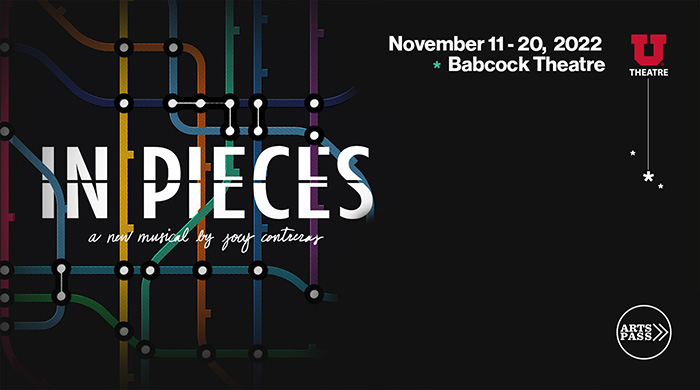Department of Theatre’s ‘In Pieces’: Performed With Intensity, But Fails to Fully Connect
November 17, 2022
Performed in the Babcock Theatre, located in the basement of the Simmons Pioneer Memorial Theatre, the most striking part of the University of Utah Theatre Department’s production of “In Pieces” is how they use the cramped space to their advantage. With only a few feet separating the audience and the performers, there is only a thin fourth wall present. The performers of “In Pieces” are able to puncture through this fourth wall to create a delicious and emotional intimacy which entirely fits the material. If performed in Pioneer Theatre or Kingsbury Hall, the humanity that “In Pieces” wants to convey would have gotten swallowed up.
A Song Cycle
There is no narrative to “In Pieces” and only the vaguest outlines of characters. “In Pieces” is what is referred to as a song cycle, made up entirely of music composed by Joey Contreras. There are no breaks for dialogue, even incidentally. Through Contreras’ songs, a foggy wisp of a theme forms. The audience follows eight young adults through the travails of love, from crushes to relationships to heartbreak.
With the characters of Charles (JT Kaufman) and Grey (Carson Peasley) we move through an unexpected friendship, the excitement of a new relationship, complications, implosions and moving onto meeting new people. We see Austyn (Alex Fish) pine from afar, get the girl and then wonder how long this fragile relationship will last. River (Lila Prince) pops in before and after a significant romantic relationship. The audience first meets Hunter (Mitchell Mosley) and Sam (Chloe McLean) as they are trying to decide whether to break off their four-year-long relationship, then lurks around as they move on before eventually coming back together.
Generic Music Fails to Express Specific Emotions and Experiences
Unfortunately, the expressionistic vignettes become a little repetitive. Does the same show need two songs in a row about pining for someone from afar? After the third song about missing an ex, one begins to feel as though this emotional territory has been covered. The form of a song cycle works against “In Pieces” because the songs cannot arise out of character.
All of the characters have the same voice, the same hope, experiences and way of describing them. As a result of the lack of specificity, they can only discuss love and relationships in broad, general terms. The song cycle never becomes the sketches of life and human existence that it wants to be.
The performers are all winning and energetic. They smile and belt as though they were in front of a crowd of thousands. However, they fail to convey lived-in experiences. Despite the performers best efforts, the music of “In Pieces” only amounts to tinny, soulless pop songs.
Although, time spent watching “In Pieces” is not ill-spent. The production passes by quickly and pleasantly, but one is struck by the fact that it could have been better. One could have learned about love and relationships while in the audience. “In Pieces” lives only on the surface, not able to get into the meat and marrow of its chosen topic, straddling the line between musical theatre and a pop concert.








